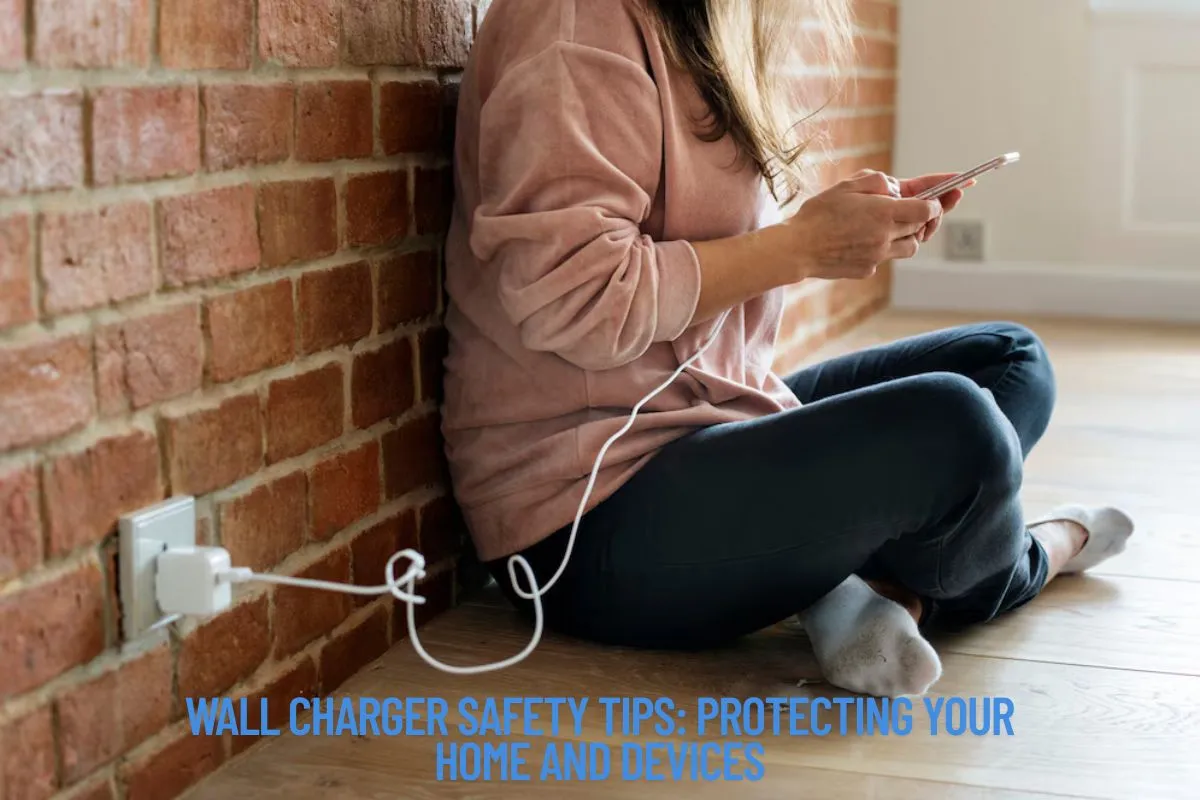
Wall Charger Safety Tips: Protecting Your Home and Devices
Wall chargers are part of our daily lives. We plug in all kinds of devices every day, from phones to tablets and even smartwatches. But have you ever stopped to think—are you charging your gadgets safely?
You might be surprised to learn how something as simple as charging your phone could pose a danger to your home or even your life if done carelessly.
Let’s walk through simple, smart, and safe tips to make sure you’re not just charging efficiently, but safely too.
Table of Contents
Toggle1. Only Use Certified, High-Quality Chargers
It’s tempting to buy a cheap charger at a gas station or online store. But what’s the real cost of that bargain?
“Always use certified chargers from reputable brands to avoid overheating and electrical hazards. Cheap knockoffs can damage your devices and even pose fire risks.”
– Jake Fisher, Senior Director of Auto Testing, Consumer Reports
Source: Consumer Reports – Are Cheap Phone Chargers Safe?
Low-quality chargers may not meet safety standards. They might overheat, short-circuit, or even explode. That’s not worth saving a few pounds.
My own story: A few years ago, I bought a cheap charger for my tablet while on holiday. Within minutes of plugging it in, it became hot to the touch. I quickly unplugged it. The plastic casing had melted slightly! That was the last time I ever trusted a knockoff charger.
Pro tip: Look for chargers with CE certification or those recommended by your device’s manufacturer.
2. Avoid Overloading Power Outlets
We all have that one power strip overloaded with chargers, lamps, and random electronics. It might seem harmless, but it can be very dangerous.
“Overloading power outlets with multiple chargers can lead to overheating and electrical fires. Use surge protectors and avoid daisy-chaining adapters.”
– John Drengenberg, Consumer Safety Director, Underwriters Laboratories (UL)
Source: UL Electrical Safety Tips
When outlets are overloaded, the wires inside can heat up fast. That heat can start a fire before you even notice something’s wrong.
Safe practice:
-
Use one charger per outlet.
-
If using a power strip, make sure it has surge protection.
-
Don’t stack one extension cord onto another (known as daisy-chaining).
3. Look for Built-In Safety Features
Good chargers aren’t just plastic boxes with wires inside. Quality models include features to protect your device and your home.
“Look for chargers with built-in safeguards like overcurrent protection and temperature control to prevent damage to your devices.”
– Ken Colburn, Tech Expert & Founder, Data Doctors
Source: Data Doctors – Charger Safety
Built-in safeguards can:
-
Stop charging once your device is full
-
Prevent overheating
-
Cut power if something goes wrong
This technology can be a lifesaver, especially if you forget your phone is charging.
4. Never Leave Devices Charging Overnight Unattended
We’ve all done it—plugged in our phones before bed and gone to sleep. But this is one of the riskiest habits.
“Never leave charging devices unattended for long periods, especially overnight. Faulty chargers can overheat and cause fires.”
– Lorraine Carli, VP of Outreach and Advocacy, National Fire Protection Association (NFPA)
Source: NFPA Electrical Safety
According to the NFPA, lithium-ion battery fires have increased due to poor-quality charging devices and habits.
Study Reference: “Analysis of Lithium-ion Battery Fires in Consumer Electronics”
Source: NFPA Study
What to do instead:
-
Charge your phone during the day when you’re around.
-
Unplug it once it’s full.
-
If you must charge overnight, place it on a hard, cool surface and far from anything flammable (no, your pillow doesn’t count!).
5. Inspect Your Charging Cables Regularly
Damaged charging cables aren’t just annoying—they’re dangerous.
“Inspect charging cables regularly for fraying or damage. Exposed wires can cause short circuits and electric shocks.”
– Lee Johnson, Electrical Safety Engineer, Electrical Safety First
Source: Electrical Safety First – Charging Safety
Frayed or bent cables may:
-
Spark when plugged in
-
Shock you when touched
-
Catch fire under the right conditions
I learned this the hard way. My old laptop charger had a small tear near the end. I ignored it… until one day, it zapped me. Since then, I have always kept my cables in check and replaced them at the first sign of damage.
Tip: Use cable protectors or sleeves to extend the life of your cords.
6. Don’t Charge Devices on Beds or Sofas
Soft surfaces trap heat. This is a major problem when charging a device thatis already heated up.
“Avoid charging devices on flammable surfaces like beds or couches. Always place them on hard, non-combustible surfaces.”
– Shane Stanberry, Fire Safety Specialist, U.S. Fire Administration
Source: USFA – Home Electrical Fires
Your bed, blanket, or sofa can act like an oven, trapping the charger’s heat and increasing the risk of combustion.
Instead, charge on:
-
Wooden tables
-
Granite or tiled surfaces
-
Desk counters
Even better? Keep the charging area clear of books, clothes, or anything else that can burn.
7. Know the Signs of a Failing Charger
Chargers don’t last forever. But how do you know it’s time to replace one?
Warning signs include:
-
Your device charges slowly or inconsistently
-
The charger becomes unusually hot
-
You hear a buzzing sound from the charger
-
The cord feels loose or wobbly in the socket
These signs point to internal damage and possible safety risks.
Study Reference: “Overheating Risks in USB Wall Chargers”
Source: Consumer Product Safety Commission (CPSC)
Link: CPSC Report
8. Be Careful When Buying Online
Online shopping can be risky, especially with electronics. Many fake chargers look just like the real ones, but don’t perform the same.
Study Reference: “Electrical Safety Hazards of Non-Certified Chargers”
Source: Underwriters Laboratories (UL)
Link: UL Research
These unsafe chargers often:
-
Lack thermal control
-
Don’t meet voltage safety standards
-
Use poor-quality materials
Tips for safer online buying:
-
Stick to well-known retailers (like Amazon or Argos)
-
Check for seller reviews
-
Only buy from verified brands
9. Use Wall Chargers Designed for Your Device
Using an incompatible charger can harm your battery and reduce its lifespan.
Study Reference: “Impact of Poor-Quality Chargers on Device Longevity”
Source: IEEE (Institute of Electrical and Electronics Engineers)
Link: IEEE Study
Phone batteries are sensitive. If charged too quickly or with the wrong voltage, they can swell, leak, or even explode.
Best practice: Match the charger’s voltage and amperage to your device’s requirements. Use the manufacturer’s original or recommended charger whenever possible.
10. Teach Your Family (Especially Kids) About Charger Safety
If you have children or teens in the house, teaching them safe charging habits is crucial. Kids often:
-
Yank cords out of sockets
-
Charge phones on beds
-
Use tablets while they’re plugged in on couches or under pillows
Set simple rules:
-
Always charge on a hard surface
-
Never sleep with charging devices
-
Unplug devices when not in use
Final Thoughts: Safety First, Always
Charging your phone shouldn’t be dangerous, but it can be if done the wrong way. The good news is that most charging risks are easy to avoid with the right knowledge and habits.
Here’s a quick recap: ✅ Use only certified, high-quality chargers
✅ Don’t overload outlets or daisy-chain adapters
✅ Charge on safe, hard surfaces
✅ Never leave charging devices unattended
✅ Replace damaged cables and old chargers
✅ Keep an eye out for overheating
✅ Educate your family on best practices
Your phone is replaceable. Your home and your life? Not so much.
Stay smart, stay safe, and charge wisely!
You May Also Like

Energy Saving Tips for Old Ovens: Practical Ways to Cut Costs
August 29, 2025
Small Changes, Big Impact: Interior Design Tips That Elevate Your Home
November 14, 2025
